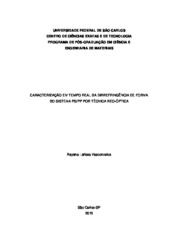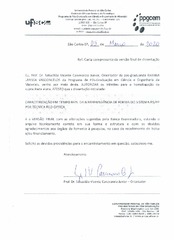| dc.contributor.author | Vasconcelos, Rayana Larissa | |
| dc.date.accessioned | 2020-03-12T14:21:01Z | |
| dc.date.available | 2020-03-12T14:21:01Z | |
| dc.date.issued | 2019-02-25 | |
| dc.identifier.citation | VASCONCELOS, Rayana Larissa. Caracterização em tempo real da birrefringência de forma do sistema PS/PP por técnica reo-óptica. 2019. Dissertação (Mestrado em Ciência e Engenharia de Materiais) – Universidade Federal de São Carlos, São Carlos, 2019. Disponível em: https://repositorio.ufscar.br/handle/ufscar/12326. | * |
| dc.identifier.uri | https://repositorio.ufscar.br/handle/ufscar/12326 | |
| dc.description.abstract | The rheo-optical behavior of polystyrene (PS), polypropylene (PP) and immiscible dilute mixtures of these polymers was studied in order to determine the flow birefringence and form birefringence of these materials. The transmitted light intensity between cross-polarizers (IN) was measured using an optical system composed of a polarized light optical microscope, a system that controls the shear and heating, and an optical detector with photoresistors. These measurements allowed to calculate the optical path difference and birefringence for each polymeric system. The IN was considerably higher for pure PS than for pure PP, due to the greater polarizability of the aromatic rings of the PS in comparison to the olefinic groups of the PP. The addition of a PP dispersed phase in the PS matrix caused a shift of the IN curve for higher shear rates, indicating a decrease in the total birefringence of the mixtures relative to the pure matrix. Conversely, the addition of a PS dispersed phase in the PP matrix generated a shift of the IN curve for lower shear rates, because there was an increase in the total birefringence of the mixtures in relation to the pure matrix. These opposite displacements agree with the additive effect of the flow birefringence of each matrix, being negative for PS and positive for PP, and of the form birefringence, always positive. Nevertheless, the form birefringence did not show a dependence of the concentration of the dispersed phase as expected. | eng |
| dc.description.sponsorship | Conselho Nacional de Desenvolvimento Científico e Tecnológico (CNPq) | por |
| dc.description.sponsorship | Coordenação de Aperfeiçoamento de Pessoal de Nível Superior (CAPES) | por |
| dc.language.iso | por | por |
| dc.publisher | Universidade Federal de São Carlos | por |
| dc.rights | Attribution-NonCommercial-NoDerivs 3.0 Brazil | * |
| dc.rights.uri | http://creativecommons.org/licenses/by-nc-nd/3.0/br/ | * |
| dc.subject | Birrefringência de fluxo | por |
| dc.subject | Birrefringência de forma | por |
| dc.subject | Caracterização reo-óptica | por |
| dc.subject | Poliestireno | por |
| dc.subject | Polipropileno | por |
| dc.subject | Flow birefringence | eng |
| dc.subject | Form birefringence | eng |
| dc.subject | Rheo-optical characterization | eng |
| dc.subject | Polystyrene | eng |
| dc.subject | Polypropylene | eng |
| dc.title | Caracterização em tempo real da birrefringência de forma do sistema PS/PP por técnica reo-óptica | por |
| dc.title.alternative | Real time characterization of form birefringence of PS/PP system by rheo-optical technique | eng |
| dc.type | Dissertação | por |
| dc.contributor.advisor1 | Canevarolo Jr., Sebastião Vicente | |
| dc.contributor.advisor1Lattes | http://lattes.cnpq.br/4153664441338178 | por |
| dc.description.resumo | O comportamento reo-óptico do poliestireno (PS), do polipropileno (PP) e de misturas diluídas e imiscíveis desses polímeros foi estudado, a fim de se determinar a birrefringência de fluxo e de forma geradas durante o fluxo cisalhante controlado desses materiais. Para isso, foram realizadas medidas em tempo real da intensidade normalizada de luz transmitida sob polarização cruzada (IN), utilizando um sistema óptico composto por um microscópio óptico de luz polarizada, um sistema de cisalhamento e aquecimento controlados e um detector óptico com fotorresistores, para quantificação dessa intensidade de luz transmitida. A partir dessas medidas, a diferença de caminho óptico e a birrefringência para cada sistema foram calculadas. A IN medida para os polímeros puros foi consideravelmente maior para o PS do que para o PP, devido à maior polarizabilidade dos anéis aromáticos do PS em relação aos grupos olefínicos do PP. A adição de uma fase dispersa de PP na matriz de PS gerou um deslocamento da curva de IN para maiores taxas de cisalhamento, indicando uma diminuição da birrefringência total das misturas em relação à matriz pura. Já a adição de uma fase dispersa de PS à matriz de PP gerou um deslocamento da curva de IN para menores taxas de cisalhamento, pois ocorreu aumento da birrefringência total das misturas em relação à matriz pura. Esses deslocamentos opostos estão em concordância com o efeito aditivo da birrefringência de fluxo de cada matriz (negativa para o PS e positiva para o PP) com a birrefringência de forma (sempre positiva). Entretanto, a birrefringência de forma não demonstrou uma dependência com a concentração de fase dispersa, não seguindo o comportamento esperado. | por |
| dc.publisher.initials | UFSCar | por |
| dc.publisher.program | Programa de Pós-Graduação em Ciência e Engenharia de Materiais - PPGCEM | por |
| dc.subject.cnpq | ENGENHARIAS::ENGENHARIA DE MATERIAIS E METALURGICA::MATERIAIS NAO METALICOS | por |
| dc.description.sponsorshipId | CNPq: 132585/2017-0 | por |
| dc.description.sponsorshipId | CAPES: código de financiamento - 001 | por |
| dc.publisher.address | Câmpus São Carlos | por |
| dc.contributor.authorlattes | http://lattes.cnpq.br/2438420639837106 | por |


